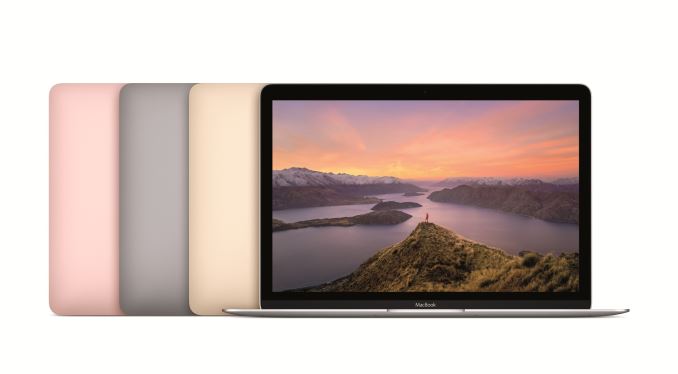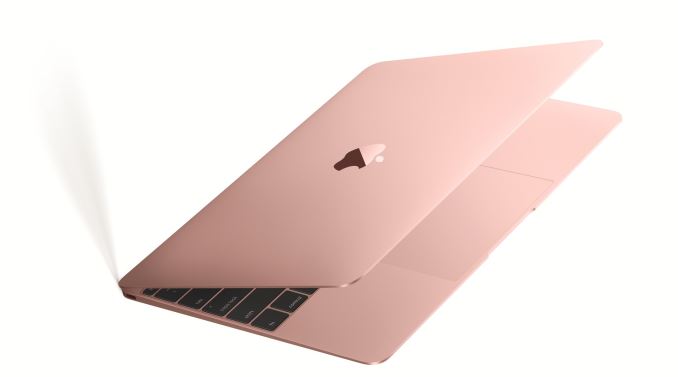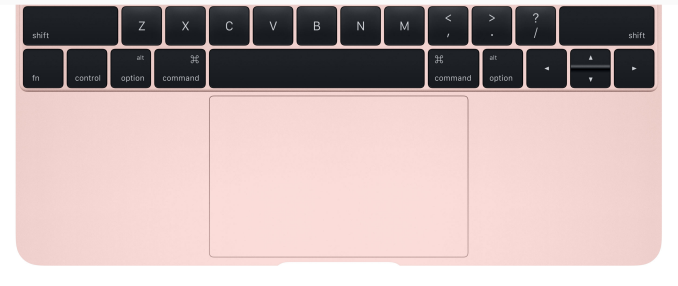Apple Refreshes MacBook with Skylake-based Core M and New Rose Gold Color
by Ian Cutress & Anton Shilov on April 19, 2016 11:10 AM EST
Today Apple has introduced its new generation of its MacBook laptops. On the specification sheets, this generation introduces Intel Skylake based Core m processors, updated integrated graphics, a faster storage solution (either controller or NAND), faster DRAM and bigger batteries. The new notebooks use the same thin chassis and retina-class display as the Broadwell-based MacBooks released last year, but in using the new Skylake silicon the new models are are expected faster and more energy-efficient, and combined with bigger batteries should mean longer battery life. Apple is also expanding the color options, bringing the popular Rose Gold option from the iPhone line to the Macbook.
The new Apple MacBook line is based on the dual-core Intel Core M processors based on the newest Skylake microarchitecture as well as the ninth-generation of Intel's integrated graphics (HD 515, Gen9) with improved media playback support. The new processors are the Core m3-6Y30, the Core m5-6Y54 and the Core m7-6Y75, but are upgraded from their listed base frequencies due to Apple using them in a 'configurable 7W TDP up' mode. This adjusts the base frequency up by 100-200 MHz and offers more TDP headroom for longer turbo periods. The latest microarchitecture and increased frequencies should increase the base performance of the new laptops in general-purpose applications whereas hardware-accelerated playback of HEVC and VP9 video streams should improve battery life in video streaming scenarios. Just like predecessors, the new laptops use 8 GB of memory, using LPDDR3 to minimize power consumption of memory sub-system. This time, Apple uses LPDDR3-1866 memory for its MacBook, which is a tad faster than the LPDDR3-1600 DRAM it used last year. This should have a knock-on effect on the integrated graphics performance as well.
| Apple MacBook Line | |||||||
| 2015 (Broadwell) | 2016 (Skylake) | ||||||
| CPU | SKU | Intel Core M-5Y31 |
Intel Core M-5Y51 |
Intel Core M-5Y71 |
Intel Core m3-6Y30 |
Intel Core m5-6Y54 |
Intel Core m7-6Y75 |
| cTDP Up | 7W cTDP Up | ||||||
| Base | 1.1 GHz | 1.2 GHz | 1.3 GHz | 1.1 GHz | 1.2 GHz | 1.3 GHz | |
| Turbo | 2.4 GHz | 2.6 GHz | 2.9 GHz | 2.2 GHz | 2.7 GHz | 3.1 GHz | |
| GPU | SKU | Intel HD Graphics 5300 (GT2) 24 EUs, Gen 8 |
Intel HD Graphics 515 (GT2) 24 EUs, Gen 9 |
||||
| Base | 300 MHz | 300 MHz | |||||
| Turbo | 850 MHz | 900 MHz | 850 MHz | 900 MHz | 950 MHz | ||
| DRAM | 8GB LPDDR3-1600 | 8GB LPDDR3-1866 | |||||
| PCIe SSD | 256 GB | 512 GB | 256 GB 512 GB |
256 GB | 512 GB | 256 GB 512 GB |
|
| PCIe 2.0 x4 | PCIe 3.0 x2 | ||||||
| Display | 12-inch 2304x1440 IPS LCD | ||||||
| Ports | 1 x USB 3.1 (Gen 1) Type-C 3.5mm combo jack |
||||||
| Network | 2x2:2 802.11ac with BT 4.0 | ||||||
| Battery | 39.7 Wh | 41.4 Wh | |||||
| Dimensions | H: 0.14-0.52-inch W: 11.04-inch D: 7.74-inch |
||||||
| Weight | 2.03 lbs (0.92 kg) | ||||||
| Colors | Space Gray Gold Silver |
Space Gray Gold Silver Rose Gold |
|||||
| Price | $1299 | $1599 | $1749 | $1299 | $1599 | $1749 ? | |
Since the chassis and the monitor essentially remained the same as last year, we are still talking about a machine with 12” IPS display panel with 2304x1440 resolution and a full-size keyboard. The maximum thickness of the new MacBook is 1.31 cm (0.52”) and the weight is 0.92 kg (2.03 pounds), similar to the first-gen model.
Apple claims that the new MacBook laptops feature upgraded solid-state storage, which relies on the PCIe bus, but it offers higher performance than the previous-gen SSD the company used on its 2015 MacBook. Last year the company essentially used its own SSD with its own controller, based on iFixit.com’s findings. Perhaps, this year Apple uses a new-gen SSD design developed in-house. Unfortunately, the company remains tight-lipped regarding the nature of its SSD improvements, but only discloses that they are faster than the predecessors. Last year's MacBook used a PCIe 2.0 x4 NVMe interface - moving to Skylake Core M and the fact that Skylake's PCH supports PCIe 3.0 by default means that the new drive is most likely PCIe 3.0, but we're not sure if it is still x4, or if something else has changed. We are asking about this!
In addition to the new components, Apple also uses larger 41.4-watt-hour lithium-polymer terraced battery, compared to a 39.7 watt-hour battery used on the previous-gen model, which should enable longer battery life. Apple itself declares up to 10 hours of wireless web browsing and up to 11 hours of iTunes movie playback, which is an hour longer than before.
The laptop still features a single USB Type-C port with 5 Gbps transfer rate, which can be used for charging, connection to an external display (up to 3840x2160 resolution at 30 Hz refresh rate is supported) and so on. The notebook also has two microphones, a TRRS connector for headsets and a 480p FaceTime camera. Wireless networking capabilities of the notebook also remained untouched: the notebook supports dual-band 2x2 802.11ac Wi-Fi as well as Bluetooth 4.0.
One element worth noting is that the use of Skylake Core M should open up features such as Speed Shift to Apple, where the system has the ability to respond quicker to CPU demands up to 30x and finish quick tasks faster than the previous generation even recognizes the request for a high-performance mode. This becomes significant for responsiveness and user experience, but Speed Shift requires specific OS support. Intel worked closely with Microsoft to enable it for Windows 10, and at this point Apple has not stated publicly if the new MacBook will support Speed Shift out of the box or will be in a future OS update.
The new Apple MacBook laptops are available from Apple directly starting today and from its partners starting April 20, 2016. The most basic Apple MacBook model with Intel Core m3-6Y30 SoC, 8 GB of memory and 256 GB of solid-state storage costs $1299. The more advanced model featuring the Core m5-6Y54 and 512 GB of storage retails for $1599. The Core m7-based model is built-to-order and its price will be higher although we expect it to be similarly priced to the upgraded Broadwell model.
Source: Apple

















106 Comments
View All Comments
nikon133 - Wednesday, April 20, 2016 - link
Personal OS preferences aside... MBA's screen is too poor for nowadays premium ultrabook standards, imho. We got spoiled withsolid screens to a degree that, for 13" size, I cannot see anything below good quality IPS 1080p as acceptable solution.I do a lot of photography and, consequently, Lightroom and Photoshop... so there's that. But even plain text in word processor looks a bit rough on 13" MBA - and yes, I had one at my disposal for a few weeks, and gave it a proper test run in that time.
I could also argue aged design - there is just too much "flesh" around screen, and 13" MBA has pretty much the same footprint as my 14" Travelmate P645s (albeit it is still significantly slimmer). I didn't have chance to try new XPS13... but from what I've read, MBA would look even more retro against it.
So... for me... if I'd insist on OSX and new MB is not enough, the only valid option for my portable needs would be 13 MBP.
tabascosauz - Tuesday, April 19, 2016 - link
You can continue under delusions that the Macbook is insufficiently powerful. Do you actually use the 1st gen Macbook on a day-to-day basis? No? I thought so.When the Macbook was first introduced, it was not at an absurd price point. Its later increase in price corresponded with similar increases in competing Windows ultrabooks, so I don't see the issue.
cygnus1 - Tuesday, April 19, 2016 - link
Works pretty well on the MacBook I have. I even run Win10 in a VM on it. That puts a little load on it, but Chrome, Safari, Messages, OneNote, all stay responsive while the VM is running... Works great in boot camp too. But I did buy this on the 7th, so it's going back and I'm getting one of these new ones.smilingcrow - Tuesday, April 19, 2016 - link
I went from an i5 4670K to a Core M-5Y71 (1.2/2.9 4M) and hardly ever feel compromised by it.Meteor2 - Wednesday, April 20, 2016 - link
Use one daily (at work, not mine). Feels fast and responsive.nikon133 - Wednesday, April 20, 2016 - link
We use a lot of Surface Pro 3 at work - all engineers use one, in fact.i5 Haswell at 1.9GHz, if memory serves... but quite keen to throttle down to 1GHz (or a bit lower?) when it becomes busy.
No complains from engineers, so I'm guessing this class of performance does indeed quite well for everyday.
Though "everyday" is quite personal, too. I tried running Lightroom on SP3... it was a bit on slow side with 20MP RAW images. But then again, even desktop i7 at 3.6GHz feels like a bit faster would be nice... couple of seconds to render previews, couple of seconds to export to JPG.
So I'm thinking - for my common needs, any of these M Core machines would probably be too slow.
willis936 - Wednesday, April 20, 2016 - link
No Core M has steady state clocks above 1.2 GHz. 1.9 GHz is indeed quite usable for typical light usage.aliasfox - Wednesday, April 20, 2016 - link
What if you're a consultant or other constant traveler who doesn't want to use their work computer in their down time? They're already lugging a 5-7lbs work laptop around, and all they want is a device to surf the web/watch videos on, but with just a bit more flexibility than a tablet?For them, the MacBook is a great option. It feels premium, is fast enough, and takes up very little space and weight in their bags that they already have to carry around all the time. And generally, a couple hundred extra dollars don't generally mean much - that's the cost of a couple hours in the hotel bar.
name99 - Tuesday, April 19, 2016 - link
It's a kind of autism, a mental defect that makes it utterly impossible for some people to imagine that anyone else has different desires and priorities from their own. Very common in the tech space.Variants include wild-eyed claims that "everyone wants to play GPU-intensive games", "everyone wants command-line access to their OS", and "everyone wants to spend 30 minutes a day fiddling around with OS settings on their devices".
And enough with the claims about living in 1999. The single biggest factor that made machines in 1999 feel slow (and that would make modern software on such machines feel even slower) was the IO performance. Remove that limitation with a high-speed SSD and you have a very different sort of machine, with a very different feel.
willis936 - Tuesday, April 19, 2016 - link
Something about apple products draw out the least intelligent consumers.